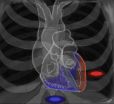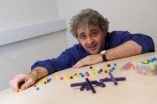Dangerous chemicals in food wrappers likely migrating to humans: U of T study
2010-11-09
(Press-News.org) University of Toronto scientists have found that chemicals used to line junk food wrappers and microwave popcorn bags are migrating into food and being ingested by people where they are contributing to chemical contamination observed in blood.
Perfluorinated carboxylic acids or PFCAs are the breakdown products of chemicals used to make non-stick and water- and stain-repellant products ranging from kitchen pans to clothing to food packaging. PFCAs, the best known of which is perfluorooctanoic acid (PFOA), are found in humans all around the world.
"We suspected that a major source of human PFCA exposure may be the consumption and metabolism of polyfluoroalkyl phosphate esters or PAPs," says Jessica D'eon, a graduate student in the University of Toronto's Department of Chemistry. "PAPs are applied as greaseproofing agents to paper food contact packaging such as fast food wrappers and microwave popcorn bags."
In the U of T study, rats were exposed to PAPs either orally or by injection and monitored for a three-week period to track the concentrations of the PAPs and PFCA metabolites, including PFOA, in their blood. Human exposure to PAPs had already been established by the scientists in a previous study. Researchers used the PAP concentrations previously observed in human blood together with the PAP and PFCA concentrations observed in the rats to calculate human PFOA exposure from PAP metabolism.
"We found the concentrations of PFOA from PAP metabolism to be significant and concluded that the metabolism of PAPs could be a major source of human exposure to PFOA, as well as other PFCAs," says Scott Mabury, the lead researcher and a professor in the Department of Chemistry at the University of Toronto.
"This discovery is important because we would like to control human chemical exposure, but this is only possible if we understand the source of this exposure. In addition, some try to locate the blame for human exposure on environmental contamination that resulted from past chemical use rather than the chemicals that are currently in production.
"In this study we clearly demonstrate that the current use of PAPs in food contact applications does result in human exposure to PFCAs, including PFOA. We cannot tell whether PAPs are the sole source of human PFOA exposure or even the most important, but we can say unequivocally that PAPs are a source and the evidence from this study suggests this could be significant."
Regulatory interest in human exposure to PAPs has been growing. Governments in Canada, the United States and Europe have signaled their intentions to begin extensive and longer-term monitoring programs for these chemicals. The results of this investigation provide valuable additional information to such regulatory bodies to inform policy regarding the use of PAPs in food contact applications.
INFORMATION:
The study was conducted by Jessica D'eon and Scott Mabury of the University of Toronto's Department of Chemistry and is published today in Environmental Health Perspectives. Research was funded by the Natural Sciences and Engineering Research Council of Canada.
MEDIA CONTACTS:
Jessica D'eon
Department of Chemistry
416-720-5256
jcurrie@chem.utoronto.ca
Scott Mabury
Department of Chemistry
416-978-2031
416-978-7116
smabury@chem.utoronto.ca
Kim Luke
Communications
Faculty of Arts & Science
University of Toronto
416-978-4352
kim.luke@utoronto.ca
END
ELSE PRESS RELEASES FROM THIS DATE:
2010-11-09
The GOES-13 satellite is watching a flurry of activity in the Atlantic Ocean today as a cold front approaches the remnants of Hurricane Tomas and threatens to swallow it in the next couple of days.
Tomas is now a remnant low pressure area is located in the Atlantic near 26 North and 68 West hundreds of miles south-southwest of Bermuda and has a minimum central pressure of 994 millibars today, Nov. 8. A cold front off the U.S. East Coast however, is stalking Tomas' remnants and moving east threatening to swallow the former hurricane.
The Geostationary Operational Environmental ...
2010-11-09
Jal was a tropical storm when it made landfall this weekend on the east coast of India and tracked across the country while weakening into a remnant low pressure area. NASA's Terra satellite captured an image of Jal's center as it was entering eastern India and NASA's Aqua satellite captured an infrared image as it was departing the country.
This weekend, Tropical Cyclone Jal made landfall in east central India and crossed the northern coast of Tamil Nadu and southern coast of Andhra Pradesh, north of Chennai. It dropped heavy rainfall and created some flooding. Gusty ...
2010-11-09
CHICAGO --- Northwestern Medicine researchers at the Robert H. Lurie Comprehensive Cancer Center of Northwestern University have found that a new, nontoxic drug made from a chemical in soy could prevent the movement of cancer cells from the prostate to the rest of the body.
These findings will be presented at the Ninth Annual American Association for Cancer Research Frontiers in Cancer Prevention Research Conference.
Genistein, a natural chemical found in soy, is being used in the lab of Raymond Bergan, M.D., the director of experimental therapeutics at the Lurie Cancer ...
2010-11-09
Saying goodbye to summer can be difficult for everybody. In some people the onset of winter triggers Seasonal Affective Disorder, or SAD, a mood disorder in which sufferers experience symptoms of depression. Happily, a special kind of gerbil exhibits remarkably similar reactions to SAD treatments as humans, opening a promising new channel for study and treatment of the common complaint.
With her work on the Israeli desert inhabitant gerbil called the Fat Sand Rat (Psammomys obesus), Prof. Noga Kronfeld-Schor of Tel Aviv University's Department of Zoology and her fellow ...
2010-11-09
New techniques now being used at UCLA allow doctors to more precisely target certain areas of the heart to stop ventricular arrhythmias — serious abnormal rhythms in the heart's lower chambers — in high-risk patients.
Generally, arrhythmias can be controlled by medications, and sometimes defibrillators. But a potentially life-threatening, recurrent arrhythmia known as a ventricular tachycardia, which originates in one of the heart's two ventricles, can produce a fast heart beat that requires other interventions, such as catheter ablation, in which the precise focus ...
2010-11-09
Children with learning difficulties can benefit from being encouraged to find their own way to solve arithmetic problems, according to new research from the University of Strathclyde in Glasgow, Scotland.
A study by Dr Lio Moscardini, in Strathclyde's Faculty of Humanities & Social Sciences, found that children deal better with arithmetical problems if they can use their own intuitive strategies such as using number blocks, drawings or breaking an equation up into smaller, simpler parts- rather than being instructed in arithmetical facts and procedures.
All the teachers ...
2010-11-09
Irvine, Calif., Nov. 8, 2010 — A small amount of bleeding in the brain seems to be common among older individuals, according to a UC Irvine study.
Neurologist Dr. Mark Fisher and neuropathologist Dr. Ronald Kim found that cerebral microbleeds are highly prevalent in the aging brain – and not primarily products of stroke-related injury, hypertension or neurodegenerative diseases such as Alzheimer's, as had been thought.
"Prior work relied on brain imaging to show cerebral microbleeds," Fisher said. "But in this study, deep regions of the brain were closely examined under ...
2010-11-09
AUDIO:
New research that reveals the activity of nerve cells in a songbird's brain as the bird sings a specific song is helping scientists to understand how birds string together sets...
Click here for more information.
A team of scientists has observed the activity of nerve cells in a songbird's brain as it is singing a particular song. Dezhe Jin, an assistant professor in the Department of Physics at Penn State University and one of the study's authors, explained that ...
2010-11-09
Hoboken, NJ – Stevens Institute of Technology and the Netherlands Organization for Applied Scientific Research (TNO) have recently conducted joint experiments in the Dutch Navy Harbor of Den Helder, where passive acoustic systems from both parties were combined. Initial experimental results are presented at the Waterside Security (WSS) 2010 conference. This important experimental campaign was financed by the Netherlands Ministry of Defence.
The collaboration between Stevens and TNO was initiated in early 2010 after recognizing a strategic opportunity to form a long-term ...
2010-11-09
Researchers at the University of California, San Diego School of Medicine and the University of Leeds have linked hundreds of federally approved drugs to more than 1,000 proteins in Mycobacterium tuberculosis, the causative agent of tuberculosis (TB), opening new avenues to repurpose these drugs to treat TB.
The study was published Nov. 4 in PLoS Computational Biology.
"Tuberculosis is currently one of the most widely spread infectious diseases, with an estimated one-third of the world's population infected and between one and two million people dying each year from ...
LAST 30 PRESS RELEASES:
[Press-News.org] Dangerous chemicals in food wrappers likely migrating to humans: U of T study





